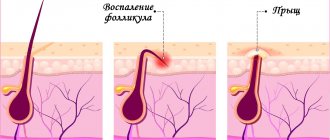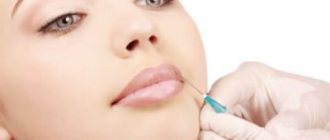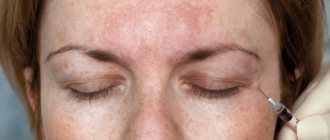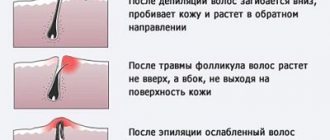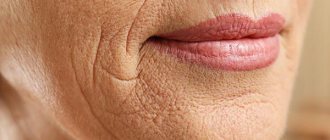Due to the property of botulinum toxin to eliminate muscle spasms, this drug is used both in medical practice and in cosmetology. The injections contain a natural purified toxin in small doses and help correct minor skin changes. The protein acts on muscle tissue, blocking the transmission of nerve impulses, as a result, facial wrinkles relax. But sometimes problems arise. Most often it happens that after Botox the eyelids droop, and the doctor should tell you what to do.
According to statistics, after a Botox procedure, 16-18% of patients experience ptosis, or drooping eyelid. No one is immune from this side effect, since in many cases it develops for reasons beyond the control of the cosmetologist. And then the first question will be, if after Botox your eyelids droop - what to do?
Symptoms
In order not to confuse ptosis after injections with other pathologies, you need to know about the symptoms. The eyelid may droop either on the third day or after a few weeks. This is very noticeable. Obvious asymmetry gives the face an unpleasant, tired expression and the gaze a heaviness. In this case, blinking is impaired, as a result the eyeball is almost deprived of hydration and cleansing, as well as:
- your eyes begin to hurt;
- blood circulation is impaired;
- headaches, strabismus and lacrimation appear.
By location, swelling is most often unilateral, but it can also be bilateral. Thus, a situation may arise when, for one reason or another, the eyelids droop after Botox. What to do? Photos and reviews of other patients, the opinions of doctors - all this is of interest, but the main thing is not to panic.
How to prevent similar complications in the future
If the eyelids have already drooped after the procedure and measures have been taken to compensate for this effect, care must be taken to ensure that this effect does not recur in the future. Since botulinum therapy itself is carried out regularly, the next procedure will require a more careful approach and take into account the high likelihood of ptosis. To prevent similar troubles from happening in the future, you must:
- The cosmetologist's warning about this effect: knowing that blepharoptosis has already happened once, the doctor will try to find out its causes and, in accordance with this, select dosages, select injection points and, possibly, sacrifice the strength of the cosmetic effect of the procedure for the sake of its safety;
The cosmetologist must be warned about complications after previous procedures so that a relapse does not recur. - Finding out the causes of the complication. To do this, it is useful to consult with another cosmetologist - if there is a possibility that the cause is a doctor’s error, it is better to have the next procedure done by another specialist;
- If, with some probability, ptosis arose due to the patient’s violation of the conditions of the rehabilitation period, then it is necessary to draw conclusions and prevent such violations in the future. Moreover, doctors’ recommendations on compliance with the rules of the rehabilitation period did not arise out of nowhere - they are the result of an analysis of side effects and complications and are developed precisely in order to reduce the risk of such consequences to a minimum.
Finally, you need to understand that the professionalism of the cosmetologist and the reputation of the clinic are the main guarantee of the safety of the procedure and the least likelihood of ptosis. An experienced and professional doctor is unlikely to make a mistake with the dosage and will not “miss” the target muscle. And even if the eyelid droops through no fault of his own, he will help cope with this defect.
Complications after Botox as a consequence of the unprofessionalism of the cosmetologist
Primary causes
Before carrying out a cosmetic procedure aimed at eliminating wrinkles in the eye area, the risks of side effects must be taken into account.
If your eyelids droop after Botox, this can happen for two reasons. Physiological, which are considered primary, are determined by the mechanisms of interaction of botulinum toxin with muscle fibers. One of them is complete or partial denervation of the muscle that raises the upper eyelid. In other words, its connections with the nervous system are interrupted and it is unable to contract. If this happens to only part of the muscle, then the remaining active one is not able to hold the eyelid completely, so it droops a little. If everything is denervated, then the eye closes completely.
The second reason is a decrease in the activity of the orbicularis oculi muscle and the one that drains lymph during contraction. As a result, tissue fluid and blood accumulate in them, swelling appears, which spreads to the eyelid. It becomes heavier and sinks.
When is swelling natural and when is it not?
Fluid accumulation and swelling may be a normal, natural response of the body to damage and injury caused by needle insertion. It is necessary to observe the condition of the swelling for 1-2 days . The swelling caused by the action of the needle will gradually decrease and disappear after 3 days without a trace.
How many days does it take for pathology to appear?
Pathological swelling after Botox may not appear immediately, but after 7–10 days. It is at this time that the toxin begins to act on the muscles and causes them to relax. There is a disruption in the circulation of blood and lymph in the tissues, stagnation of excess fluid occurs, and swelling around the eyes occurs.
We invite you to watch a video about the occurrence of swelling after the Botox procedure:
Secondary causes
The answer to the question of why eyelids droop after Botox torments everyone who has encountered this problem. Secondary reasons are due to the specifics of the procedure itself and rehabilitation after it. Although the principle of action of the drug is the same for all patients, in some the intervention proceeds well, while in others undesirable effects occur.
Drooping eyelids after botulinum toxin injections can result from:
Also, too high a dosage can lead to this result. In this case, this is a consequence of inaccurate injections or improper dilution of the solution. Overdose often occurs among doctors who, following a new trend, inject botulinum toxin in large doses. Although 10 units of the drug are usually enough for a pronounced effect, they administer from 35 to 50. High dosages, in addition to making the rejuvenation procedure more expensive, also increase the risk of various kinds of complications. This approach is absolutely not justified, because if the effect of 10-15 units seems too small, the missing amount can always be added a little later.
If at the very beginning there are signs of ptosis on the face, then, first of all, it is necessary to cure it, and then carry out the procedure, because initially the muscle tone is not normal.
Why does drooping eyelid occur?
Many women, seeing unpleasant changes, begin to blame the cosmetologist; the occurrence of complications in the form of ptosis is not always the fault of the specialist. There is a personal perception of the product by the body. Botox is not suitable for everyone and causes an allergic reaction in some.
The main causes of ptosis of the upper eyelid are:
- Incorrectly selected points for entering the composition. Before injecting, the doctor must examine the client’s face and determine the places where the injection can be given.
- Incorrect administration of Botox. The syringe with the needle must be positioned at a certain angle, usually 45 degrees, to reach the desired depth. If the injection is done incorrectly, complications can result not only in eyelid ptosis, but also swelling and bruising.
- Incorrectly calculated dose. After the doctor examines the structural features of the client’s face, he must determine the required dosage of Botox. The forehead area requires 10–15 units of the drug.
There are also reasons for ptosis of the upper eyelid after Dysport or Botox due to the client’s fault:
- The habit of sleeping face down on a pillow after administration of the drug is prohibited.
- Mechanical impact at the injection site. Do not touch the injection area with your hands, rub or scratch it.
- Taking a hot bath and using a hairdryer immediately after the procedure.
- Lying down or tilting your head after Botox injection.
In order not to get ptosis of the upper eyelid instead of a rejuvenating effect, you should carefully select a specialist, study certificates and diplomas, read reviews of the work, and follow recommendations after the procedure.
How long should I wait for the natural return to rise?
Of course, in such a situation, women are interested in whether their eyelids droop after Botox, when the trouble will go away. Botulinum toxin is eliminated from the body gradually, as soon as its concentration begins to decrease, the asymmetry disappears, therefore one of the best medicines is time. The recovery process will end in two weeks, and may last for several months. It depends on the:
How does Botox work?
Botox is a drug based on botulinum toxin A, which is injected into the facial muscles, causing their paralysis. It helps smooth out wrinkles and gives skin elasticity. Despite the fact that injections with the product have been successfully used by cosmetologists since 1980, like any medical intervention, the procedure can be complicated by drooping eyelids.
Interesting! The distribution of the toxin in the soft tissues of the face depends on its concentration and diffusion. The higher the indicators, the greater the opportunity to paralyze neighboring muscle groups.
Ways to eliminate ptosis after Botox
After Botox injections, the eyelids drooped, those who have such a complication want to know what to do. The first thing you need to do is contact a cosmetologist. After the inspection, he will establish a sequence of actions to correct the problem. Ptosis is a reversible process, but the duration of therapy is difficult to determine. Doctors have several treatment methods at their disposal, the use of which can speed up the overall restoration of energy in paralyzed muscles and improve the appearance of the face.
Indications for accelerated elimination after an unsuccessful procedure
Sometimes, despite the experience and skill of a specialist, Botox does not apply successfully and the result of the procedure does not live up to expectations. The probability of such a turn of events is less than 5%, but not a single patient is immune from it.
The reason for this may be:
- degree of susceptibility to botulinum-containing drugs;
- development and location of facial muscles;
- presence of undiagnosed hernias;
- old injuries;
- non-standard location of the facial nerve.
There are other possible reasons for unsuccessful botulinum therapy:
- unintentional drug overdose;
- insufficient quality of the drug;
- incorrect actions of the patient himself in the postoperative period.
As a result of an unsuccessful botulinum therapy procedure, unforeseen symptoms may develop , which will make the patient want to immediately get rid of the consequences of the injection:
- facial asymmetry;
- numbness of lips and speech impairment;
- curvature of the corners of the mouth and drooling;
- ptosis of the eyelids - from slight drooping to complete inability to open the eyes;
- eyebrow ptosis;
- all kinds of visual impairments - primarily double vision;
- lymphostasis in the area between the eyebrows.
Sensations of tight muscles and unnatural facial expressions can cause serious discomfort, and a patient who is not ready for this may turn to a specialist with a request to relieve him of Botox.
More serious complications are also possible - allergies, suffocation, anaphylactic shock, etc. Here, emergency assistance from a surgeon and hospitalization of the patient will be required, since there is a direct threat to life.
You can learn more about side effects from this article.
We invite you to watch a video about complications for which removal is recommended:
Administration of another dose of botulinum toxin
If after Botox the upper eyelids droop, then the cosmetologist may decide to inject another dose of the drug into the fibers that lower the upper problematic eyelid. This method will help balance the strength of the muscles, after which the eye will open normally.
There is another option that can be used for mild ptosis. The cosmetologist finishes off the muscles that raise the eyebrow on the opposite side. After this procedure, it will lower slightly, the size of the eyes will become almost the same and the asymmetry will be barely noticeable.
How to avoid negative consequences
In anticipation of the procedure, it is better to stop taking medications that thin the blood, do not drink alcohol, or smoke: all this can lead to increased bleeding during injections.
And most importantly, you shouldn’t take risks by coming to someone’s home or even a beauty salon for a procedure based on a positive review from a distant relative of a close friend. In the best case, careless injections will cause bruises, in the worst case, an infection can occur. You need to find a clinic with a medical license.
It is recommended to monitor cosmetologists with good ratings in advance, and when meeting in person, ask for proof of medical education and existing certificates.
Beauty is important, but health is certainly no less, so it is better to discard embarrassment and unfounded trust.
Drug treatment
Modern methods of correcting the situation when eyelids droop after Botox include the use of medications that will help speed up the restoration of mobility of problem muscles and strengthen nearby fibers.
For these purposes the following are often prescribed:
Course use of Apraclonidine allows you to raise the edge of the eyelid by approximately 1-2 mm. This is sufficient for mild to moderate ptosis, but for severe ptosis this method is only suitable as part of complex therapy.
Physiotherapeutic procedures
If your eyelids droop after Botox, then one of the treatment methods should be physiotherapeutic procedures. Their main task is to restore the lost vital activity of muscle fibers in the shortest possible time. The most effective include myostimulation and microcurrents. The procedures are quite expensive, but with their help it is possible to quickly get rid of swelling and cope with ptosis.
All types of massage bring good results, this also applies to kneading the problem area yourself with your fingers.
Traditional methods
If it so happens that your eyelids droop after Botox, you can try to treat it at home, resorting to special procedures, namely, making warm compresses and inhalations using medicinal herbs.
A positive result will be obtained by applying a boiled egg in the shell, a bag of heated cereal or salt to the forehead or between the eyebrows for 15-20 minutes. The procedure should be carried out every day. But it must be borne in mind that this thermal method can be used if there is no swelling.
You can do a little massage yourself at home. First, it is recommended to apply a cream that has a tightening effect to the area around the eyes and eyelids to create additional hydration and enhance the effect. Then you need to perform circular stroking, light pinching and patting in a clockwise direction. Thanks to massage movements, the drug begins to be removed from the cells faster.
Facial inhalations performed over herbal decoctions, such as:
For this procedure, one of the listed herbs should be brewed with boiling water, poured into a pan, over which you need to bend and inhale the aroma for 5-10 minutes.
Paraffin eyelid masks can help in this difficult situation. To do this, you need to melt the paraffin and add 2 drops of lavender oil. Dip napkins in the resulting mixture, apply to the eyes, do not touch the eyelashes. After the composition has hardened, remove.
How to prolong the effect of treatment?
If the patient carefully follows all the recommendations and prescriptions of the cosmetologist regarding the treatment of drooping upper eyelids, then eventually this complication gradually disappears. To consolidate the result, it is advisable to listen to simple advice. One of them concerns the need to continue to massage to keep the muscles toned. Doctors recommend starting to do gymnastics specifically designed for the face - face building. It helps train muscle fibers. It is necessary to apply a firming eye cream every morning and evening. A mask using gelatin can help a lot. You should mix 1 tbsp. l. gelatin and milk. After it dissolves, add a capsule of vitamin A and E and apply the mixture to your eyelids. Once it dries, wash using warm water.
Can ptosis go away on its own?
Drooping of the upper eyelid caused by Botox goes away on its own when the drug wears off. Nerve cells, the functioning of which was suspended by the drug, form new processes and begin to re-contact the muscle, restoring its functions after ptosis.
The growth of new processes of nerve cells begins to appear on the second or third day after the injection, but they develop slowly; muscle activity of the face takes a long time to recover after ptosis.
Ptosis of the upper eyelid is considered one of the serious consequences after Botox, aimed at improving appearance and rejuvenation. Cosmetologists and doctors do not advise waiting for the defect to be eliminated on your own.


